Yesterday I played my first chess of the year, getting together with Gjon Feinstein and Mike Splane and Juande Perea and Austen Green for speed chess. I had a very good time except for the fact that I kept losing on time. Five-minute chess is not my thing, especially yesterday. I kept getting “brain locks” where I would take 60 seconds or 90 seconds on a move, which you can’t afford to do in speed chess.
Nevertheless, I did get some interesting positions. Here was an endgame position against Gjon that all five of us spent quite some time analyzing.
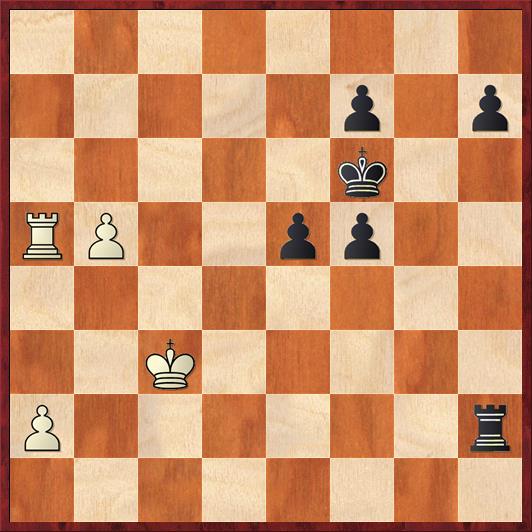 Position after 1. Kc3. Black to move.
Position after 1. Kc3. Black to move.
FEN: 8/5p1p/5k2/RP2pp2/8/2K5/P6r/8 b – – 0 1
I was White and Gjon was Black. My flag had already fallen by this point, but we were continuing to analyze the position just to see “what would have happened.” I should mention that this is quite normal when you play speed chess with Gjon. He is every inch a chess student and chess teacher. Even though the outcome of the game is important to him, learning from it is even more important. So a typical speed game with him lasts thirty minutes: ten minutes to play the game, twenty to analyze it!
In this position, in spite of the fact that Black is two pawns ahead, he really has to think about saving the draw. White’s king is perfectly placed on c3 — denying Black’s rook access to the b-file, yet just close enough to the kingside that Black is doomed in a pawn race. Thus, 1. … e4 2. b6 e3 3. b7 e2 does not work because of 4. Kd2! Pushing the f-pawn also fails in an intriguing way: after queening his pawn, Black falls into an instant checkmate: 1. … f4 2. b6 f3 3. b7 f2 4. b8Q f1Q 5. Qxe5+ Kg6 6. Qg5 mate! A really unusual case of an “epaulets mate” in the middle of the board.
So Black needs to defend, and the logical place to start is to chase White’s king away from its ideal position. Gjon said he would have played: 1. … Rh3+. I would have played 2. Kd2, because 2. Kc4 is entirely too risky: 2. … f4 3. b6 f3 4. Kc3 Rh1! White has to play 5. Ke3 to stop the pawn, and this gives Black time to play 5. … Rb1 and get behind the passed pawn.
Now Black has an easy, brain-dead way to draw, which for some reason none of us suggested: simply 2. … Rh2+, and there’s nothing better for White than 3. Kc3 repeating the position. This was an example of how five heads can be worse than one.
But Gjon had a different idea: he wanted to play 2. … e4?! The point is that after 3. b6 Rd3+! 4. Ke2 Rd8 5. b7 Rb8 he is in time to stop my passed pawn. While this is obviously riskier than taking the immediate draw by repetition, it also has one notable advantage: if White screws up, Black could still win. In any case, it leads to a very interesting endgame. I’ll put in another diagram here so you can follow along.
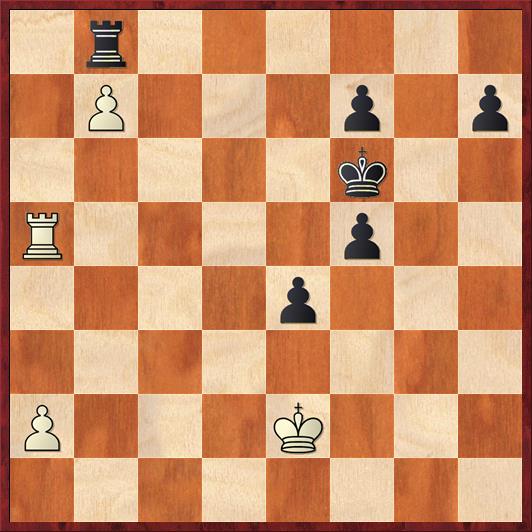 Position after 5. … Rb8. White to move.
Position after 5. … Rb8. White to move.
FEN:1r6/1P3p1p/5k2/R4p2/4p3/8/P3K3/8 w – – 0 5
Here, for instance, is a position where it’s possible for White to screw up. Which way should he defend the pawn, with Rb5 or Ra7?
The correct move is 6. Rb5! Not 6. Ra7?? because Black wins with 6. … h5!! 7. a4 h4 8. a5 h3. It transpires that White cannot stop the pawns with his king, and if he continues his plan with 9. a6 h2 10. Ra8 h1Q 11. Rxb8, he falls victim to an ultra-ultra-long fork with 11. … Qh2+! This is so cute that I’ve got to put in another diagram.
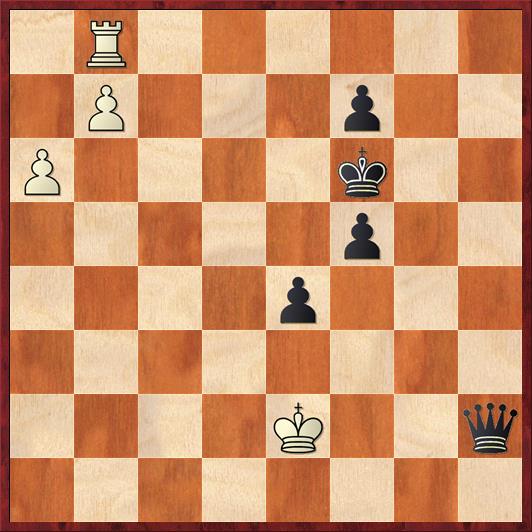 Position after 10. … Qh2+. White resigns.
Position after 10. … Qh2+. White resigns.
FEN: 1R6/1P3p2/P4k2/5p2/4p3/8/4K2q/8 w – – 0 11
Back to the second diagram position. As I said, 6. Rb5! is forced because White needs to be able to use his rook for defense as well as attack. Now 6. … h5?? no longer works for Black, because White’s pawn advances to a6 and then his rook retreats to b1 just in the nick of time.
However, the downside of 6. Rb5 is that White’s rook is one file closer to Black’s king, so it’s natural to ask what happens after 6. … Ke6 7. a4 Kd6 8. a5 Kc6. Isn’t Black just winning?
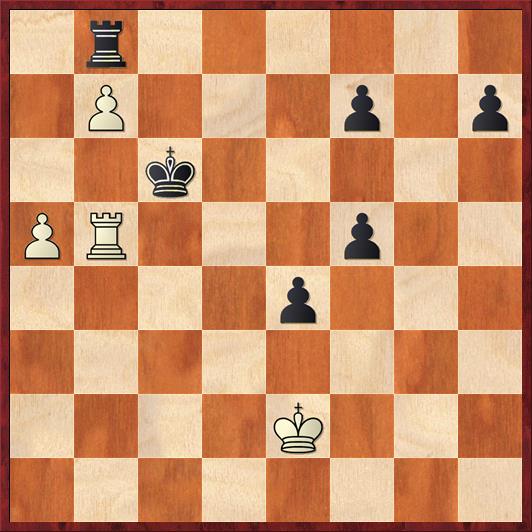 Position after 8. … Kc6. White to move.
Position after 8. … Kc6. White to move.
FEN: 1r6/1P3p1p/2k5/PR3p2/4p3/8/4K3/8 w – – 0 8
The beauty of rook and pawn endgames is that they are all about tempi, and even one tempo can sometimes be worth a pawn, two pawns, even a whole rook. Such is the case here, where White sacrifices all of his remaining material in order to queen a pawn:
9. a6! Kxb5 10. a7! Rxb7 11. a8Q
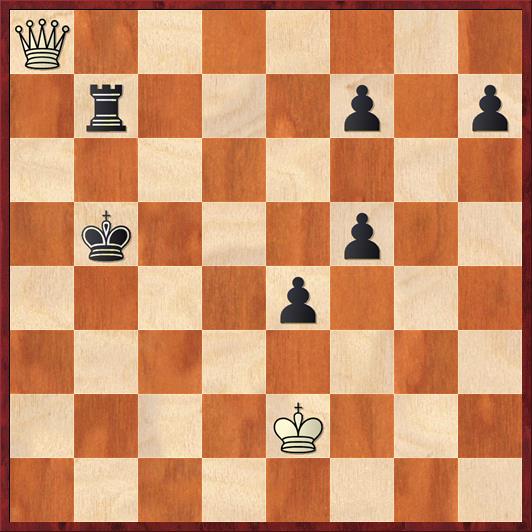 Position after 11. a8Q. Black to move.
Position after 11. a8Q. Black to move.
FEN: Q7/1r3p1p/8/1k3p2/4p3/8/4K3/8 b – – 0 11
Mission accomplished! But White isn’t done yet. Black has a rook and four pawns for the queen! Can White win this? Should White win this?
To be honest, I don’t know, and so I want to leave this as an open question for my readers. I can tell you this: for Black to draw this game, if he can draw it, he has to know exactly what he is doing. Rook and one pawn can sometimes draw against a queen, if Black can reach the right “fortress” position. Rook and two connected pawns have good chances of drawing against a queen — if the rook is actively posted.
The case for a White win: In this position, Black is not well situated to activate his rook and his advanced e- and f-pawns are easy targets. In fact, they are probably goners. If Black is left only with his pawns on h7 and f7, I think that White is probably winning.
The case for a draw: It’s going to take White some time to round up all those pawns, so who knows? White will probably have to bring his king to f4 if he wants to have any chance of winning the f5 pawn. But this will release the blockade of the e-pawn. If Black can safely position his rook on the e-file, then … e3 will establish the e-pawn as a major threat. If White is forced into blockading with the queen, his winning chances will evaporate.
Here is some sample Rybka analysis. It is not meant to be definitive — I definitely don’t trust computers in this kind of endgame — but it seems like reasonable play for both sides.
11. … Rd7 12. Qe8 Kc6 13. Ke3 Kd6 14. Kf4 Re7 15. Qb8+ Ke6 (this seems a bit cooperative, but it’s what Rybka wants to do. I can see that 15. … Kd5 16. Qd8+ has problems too.) 16. Qe5+ Kd7 17. Qxf5+ Kd6
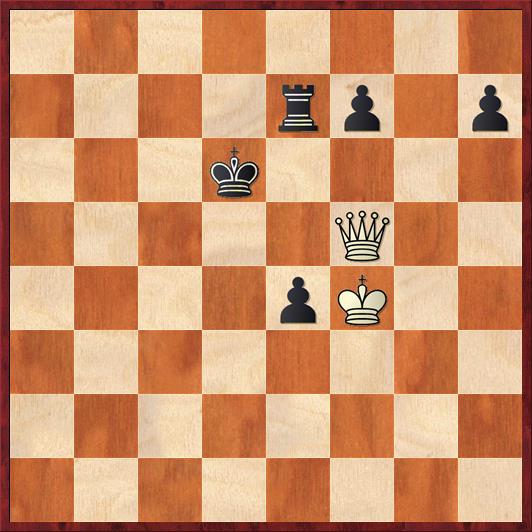 Position after 17. … Kd6. White to play and win. I think. Maybe.
Position after 17. … Kd6. White to play and win. I think. Maybe.
FEN: 8/4rp1p/3k4/5Q2/4pK2/8/8/8 w – – 0 17
First comment: We are now down to a seven-piece endgame, which should be in the Lomonosov tablebases. You have to pay money for those, however, so I don’t have access to them. However, there is easy online access to the six-piece (Nalimov) tablebases. So I can look up the position after 18. Qxh7? and tell you that it’s a draw with perfect play.
Although I’ve expressed my distrust of computers in this kind of endgame, here Rybka comes up with a really nice move: 18. Qc8! The idea is to pry Black’s rook away from the defense of the e-pawn with Qd8+. For instance, if 18. … e3 19. Qd8+ Ke6 20. Kxe3. We are now in a six-piece (Nalimov) endgame, so I can tell you that with perfect play for both sides, White is winning. But in case that leaves you feeling unsatisfied, in human terms the point is that Black has not been able to set up a fortress position with his rook defended by a pawn. Of course, it’s one thing to say that, and another thing to actually win the game.
Well, this seems like a good place to stop. We’ve now gone 20 moves past the original position, which itself was several moves past when I lost on time! Definitely this is a case where the analysis was far more memorable than the game itself.
By the way, Happy New Year to everyone!



{ 6 comments… read them below or add one }
The interesting position occurred one move earlier than your starting position. Move the black pawn on d5 back to d6 and the White king on c3 to d3 Black played 0 …. e5 and White played 1. Kc3.
The move 0 …e5 s a bad mistake because it wastes a critical tempo. As we learned in our post-mortem, there were several variations where both sides queened that White only won because he queened first.
While watching the game, as it was in progress, before Black played 0. d5, I was thinking that Black had to accomplish two things to win. A. get his rook behind the g pawn and B. push the c pawn and make a queen. The main candidate moves must be Rg2 and c4. Using the principle of make necessary moves first, then c4 must be right; it’s not clear where the rook belongs so it should not be committed too early. The 0. d5 move caught me completely by surprise.
I don’t see any way for White to save the game after 0… c4
If 1. Kd4 Kb5 2. g6+ c5+ 3. Kc3 Rg2 4. Rh6 d5 and White gets mated or loses all of his material If 3. Kd5 Rg2 4. Kd6 Rg6+ 5. Kd5 c3 wins.
If 1. h4 Rg2 2. Kf3 Rg1 3. Kf2 c3 4. Kf1 c2
If 1. g6 Rg2 2. Rh6 c3 3. Kf3 Rg1 4. Kf2 c2 5. Kf1 c1=Q+ and the rook falls.
If 1. Rh3 Ra3+
If 1. Rh4 Kc5 2. Rg4 Rh2 3. g6 Rh8 4. g7 Rg8 and the advance of the queenside pawns can’t be stopped.
If 1. Kf3 c3 2. g6 c2 3. g7 c1 = Q 4. g8=Q Qd1+ and Black wins at least a rook.
5. Kg3 Qg1+
5. Kf4 Rf2+ Ke4 Qe1+ and mates on the a fle.
5. Ke3 Re2+ and skewers the queen
5. Ke4 Re2+ 6. Kf5 Qf1+ 7. Rg2+ Rg5 8. Rg5+ Kg5 9. Qg2+
If 1 Kf4 c3 2. Rh3 Ra4+ 3. Kf5 Ra5+ 4. Kf6 c2 5. Rc3+ Rc5
or 4. Ke3 Rc4 5. Kd3 c2 6. Kc4 c1=Q+ 7. Rc3 Qg5
It was definitely a fun endgame to analyze.
-Mike
Hi Mike,
You’ve got your files reversed for some reason (e.g., you talk about a c-pawn when you mean the f-pawn) but it’s easy enough to do the translation in my head.
I actually disagree with your first statement, but it really depends on the perspective you are taking. If you want to understand how Black should win this position where he was up two pawns, you’re right that you need to go back to move 0, with White’s king on d3 and Black’s pawn on e6. If you want to understand how White can save or even win this two-pawns down endgame, which I think is more interesting because it’s more unusual, then the position on move 1 is the one to start with. Both points of view are perfectly valid depending on what you want to learn. What finally tipped the balance for me and made me decide to start on move 1 rather than move 0 was this amazing variation that goes to the queen versus rook and four pawns endgame. That was something that we failed to notice during the post-mortem, either because I played inferior moves for White or Gjon played inferior moves for Black (I don’t know which), but it’s a real bonus and in fact that was the title I gave to this post. If I start on move 0, then to get to the Q-vs-R+4P endgame I have to start with a blunder on Black’s first move. If I start on move 1, then Black’s first move is correct and his second move, while not best, is the only way to play for a win. From there on, best play for both sides leads straight to the Q-vs-R+4P ending. So just as an endgame study, it is better to start with move 1.
Still, great comment, and it shows how very rich this endgame was.
“First comment: We are now down to a seven-piece endgame, which should be in the Lomonosov tablebases. You have to pay money for those, however, so I don’t have access to them.”
Today there is also free access to the Lomonosov tablebases with 7 pieces if you have an android GSM. The app contains a huge amount of very attractive features.
A close friend wrote an article about it and I just finished the translation to English on my blog: http://chess-brabo.blogspot.be/2016/01/lomonosov-7-men-tablebases.html
Brabo,
Thanks for the great information! I don’t have an Android phone unfortunately, so I still seem to be stuck in the world of having to pay for the Lomonosov tablebases. The examples you show in your review article look really impressive, though! I can only hope that such programs will eventually make their way to the iPhone world.
Of course the Lomonosov tablebase won’t be able to say anything about the Q-vs-R+4P ending, but it would be able to evaluate the position after 17. … Kd6 (the last diagram), which to me is a very critical one. Can you tell me what the evaluation is?
If the position on move 17 is lost for Black, it would be interesting to browse through the other pawn and rook setups that Black could possibly have gotten to and see if there is one that would hold the draw. But that is already a bigger project.
“Can you tell me what the evaluation is?”
Hmm I neither have an android nor an iphone. My friend, the writer of the original text in Dutch has.
However why don’t you use the finalgen: http://finalgenchess.ovh/home_ing.php
You can download it for free. I expect that it will definitely solve the position with 7 pieces if you give the tool an hour on a fast computer. You could try to use it also for the starting position of 8 pieces but I guess it will take too long and too much diskspace.
Just downloaded the app and entered the last diagram. It shows white mates in 44.